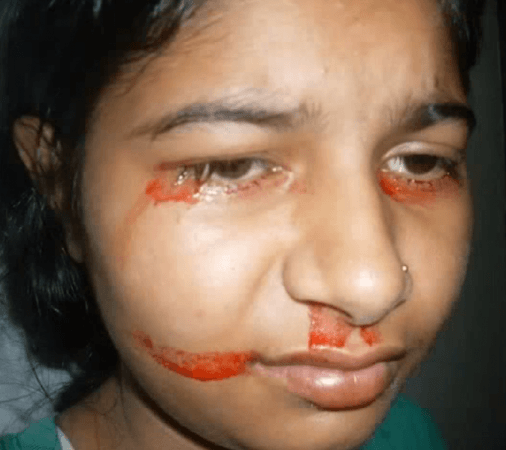
Remember the X-Men movies where mutants were treated as a threat to society because of a genetic anomaly that made them different from humans?
Something similar has happened to a 21-year-old woman from the north Indian state of Bihar. She suffers from a rare medical condition that causes her to "sweat" blood from her eyes – something that has made her disgusted husband abandon her because he thinks she is a "witch."
Geeta was treated at the Sardar Hospital by Dr Vinayak Singh, who found that despite her blood-clotting cells functioning properly, she has developed a painless condition known has hematohidrosis all of a sudden, causing the shocking bleeding, Daily Mail Online reported.
Her father, a laborer, is "afraid and helpless" as Geeta's disorder has already spread and begun affecting other parts of her body. As of now, her current condition is unknown.
However, Geet isn't the only one who has been branded as something evil. The now 18-year-old Preeti Gupta, from Delhi, India had also mysteriously started bleeding from her skin back in 2009, when she was just a little child.

In a 2014 interview with Daily Mail Online, Preeti had shared the consequences of her condition having been barely heard of. "Some people have said ghosts or evil spirits possesses me. It's been terrifying," the then 15-year-old had said.
Her father had also mentioned the bizarre lengths people would go to, to try and debunk her condition. He shared: "Some of them accuse her of scratching her skin so bad it bleeds or killing animals and smearing their blood all over her body. But who would ever do such a thing to draw attention?"
Although this is a one in 10 million occurrences, another Indian girl had made news a while ago with the same disorder, which would cause sudden bleeding from her eyes and scalp.
In 2010, the then 14-year-old Twinkle Dwivedi had caused widespread confusion among Indians when her mother reported that the teenager would "cry blood." It seemed suspicious to people how the mysterious "bleeding" would happen only when nobody was around.
Another young girl from Thailand reported a similar condition in 2016. The seven-year-old Phakamad Sangchai, from Nongkghai, bled from her eyes, nose, ears and skin every time she would get a headache.
Even though she was able to receive required medical treatment at a local hospital, Phakamad's condition persists and has left her family helpless.
The little girl, who is also suspected to have hematohidrosis, told Daily Mail: "I don't want to be famous, but I just want someone to help me with this mystery illness. It is really spoiling my life and I am so concerned that it will get worse. They tell me that only one person in 10 million people gets this sickness."
Her distressed mother — desperately seeking medical help for her child — said: "The doctors are not 100 percent sure what the diagnosis is, we can only hope they will find out soon."
In the recent past - around October 2017, another Italian woman had appeared on the news after her face and palms began to bleed without any visible scratches or injuries. Her name and identity still remain withheld but the symptoms were similar to other reported cases of hematohidrosis - as CNN had reported.
What is Hematohidrosis?
Hematohidrosis most commonly occurs on the face and forehead – and this "sweating" usually happens when the patients feel intense fear or stress. The release of chemicals like adrenaline can trigger capillaries to rupture, leading to blood exiting via sweat glands, HealthLine reports.
Some experts also believe that hematohidrosis occurs due to menstrual blood exiting the body from parts other than the uterus.
Little is known about the condition, but it doesn't pose fatal threats to the patient. The treatment involves identifying the trigger, and patients are usually prescribed antidepressants or anti-anxiety medication.















